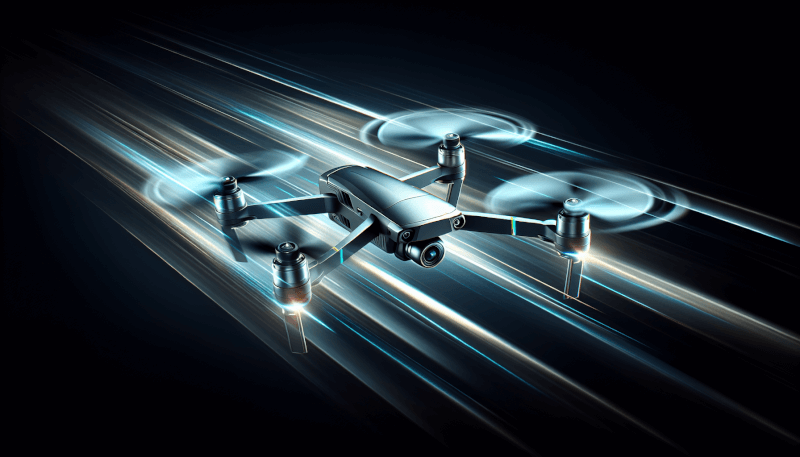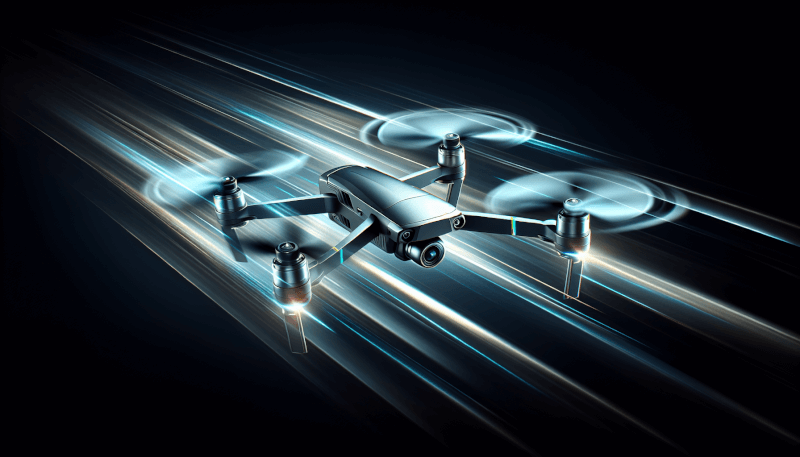If you’re a drone enthusiast seeking to optimize the performance of your beloved flying machine, look no further. In this article, we will explore the best techniques to maximize the performance of your drone’s motors. Whether you’re a beginner or an experienced pilot, these tips and tricks will help you elevate your drone experience to new heights. From proper maintenance to understanding motor specifications, prepare to unlock the full potential of your drone’s motors and take your aerial adventures to the next level.

Optimize Motor Selection
Consider Motor Kv
When selecting a motor for your drone, one important factor to consider is the Kv rating. Kv refers to the number of revolutions per minute (RPM) that the motor will turn per volt applied. Higher Kv motors tend to provide more RPM for a given voltage, which is beneficial for applications that require high-speed maneuvers. On the other hand, lower Kv motors provide more torque and are better suited for applications that require heavier payloads or longer flight times. Consider the specific requirements of your drone and choose a motor with an appropriate Kv rating.
Choose the Right Motor Size
Another important aspect of motor selection is choosing the right size. The size of the motor will determine its power output and efficiency. Larger motors generally offer more power, but they can also add weight to your drone. Smaller motors, on the other hand, are lighter and more compact, but they may not provide sufficient thrust for certain applications. Consider the size and weight of your drone, as well as the specific requirements of your flight missions, to choose the motor size that strikes the right balance between power and weight.
Select Motors with High Efficiency
Efficiency is a crucial factor in motor selection as it directly impacts the overall performance of your drone. Higher efficiency motors convert a larger percentage of electrical energy into mechanical energy, resulting in longer flight times and increased overall performance. Look for motors with high efficiency ratings to maximize the performance of your drone’s motors. Additionally, consider motors that offer efficient cooling mechanisms, as excessive heat can negatively affect motor performance and lifespan.
Ensure Proper Motor Mounting
Use Secure Motor Mounts
When mounting your drone motors, it is essential to use secure mounts to ensure they stay in place during flight. Loose or poorly secured motor mounts can lead to vibrations, which can compromise flight stability and cause unnecessary wear on the motor and other components. Use high-quality motor mounts that are specifically designed for your drone model to ensure a secure and reliable mounting solution.
Ensure Proper Alignment and Balance
Proper motor alignment and balance are crucial for optimal performance and durability. Misaligned or unbalanced motors can cause vibrations, which can affect flight stability and cause premature wear on the motor bearings and other parts. Use precision tools to align and balance your drone motors, and periodically check for any misalignment or imbalance. Making the necessary adjustments will help maintain smooth and efficient motor operation.
Implement Efficient Propeller Selection
Consider Propeller Size and Pitch
Choosing the right propeller size and pitch is key to maximizing the performance of your drone’s motors. The propeller size and pitch determine the amount of thrust generated and the efficiency of the motor’s power transfer. Larger propellers generate more thrust but can put a heavier load on the motor and reduce flight time. Smaller propellers offer increased agility but may sacrifice some lifting capabilities. Consider the specific requirements of your drone and select propellers that strike the right balance between thrust, efficiency, and maneuverability.
Use Balanced and High-Quality Propellers
Unbalanced propellers can cause vibrations that adversely affect both the motor and the overall flight performance of your drone. To ensure smooth and efficient operation, use balanced propellers that have been carefully matched and tested. High-quality propellers made from durable materials also contribute to better performance, as they resist flexing or warping during high-speed rotations. Invest in reputable propeller brands that offer reliable performance and durability.
Opt for Carbon Fiber or Composite Propellers
For even higher performance and durability, consider using carbon fiber or composite propellers. These materials offer a lightweight yet rigid construction, resulting in improved efficiency and increased thrust-to-weight ratio. Carbon fiber and composite propellers are less prone to warping or breaking under high-speed rotations, making them an excellent choice for drones that require maximum performance and durability.
Maintain Proper Voltage and Current Levels
Use Quality LiPo Batteries
The voltage and current supplied to your drone motors play a crucial role in their performance. To optimize motor performance, use high-quality LiPo (Lithium Polymer) batteries that are specifically designed for drones. LiPo batteries offer a high energy density, providing sufficient power to meet the demands of your drone’s motors. They also offer a lighter weight compared to other battery types, reducing the overall weight of your drone and improving its maneuverability.
Optimize Battery Voltage and Capacity
Ensure that the voltage and capacity of the battery you use are suitable for your drone’s motor requirements. Higher voltage batteries can provide increased power output, resulting in improved motor performance. However, be cautious not to exceed the maximum voltage rating of your motors and electronic speed controllers (ESCs), as this can lead to irreversible damage. Consider the specific voltage and capacity requirements of your drone’s motors and choose a battery that can meet these requirements without compromising safety.
Monitor Current Consumption
Monitoring the current consumption of your drone’s motors is essential to ensure they are operating within safe and efficient limits. Excessive current draw can indicate issues such as motor inefficiency, propeller damage, or even battery problems. Use a current sensor or power meter to measure the current consumed by your motors during flight and compare it with the manufacturer’s specifications. Regular monitoring allows you to identify any potential issues early on and take appropriate action to maintain optimal motor performance.

Proper Motor Cooling and Heat Management
Ensure Sufficient Airflow
Efficient motor cooling is vital to prevent overheating and ensure optimal performance and longevity. Ensure that there is adequate airflow around your drone’s motors, especially during intense flights or in warm weather conditions. Avoid enclosing the motors in a tight space or covering them with excessive heat-trapping materials. Encourage natural airflow by providing proper venting or cooling holes in your drone’s frame or motor mounts. Sufficient airflow will help dissipate heat and maintain the motors’ operating temperature within safe limits.
Use Cooling Fans or Heat Sinks
In addition to natural airflow, you can also utilize cooling fans or heat sinks to aid in motor cooling. Cooling fans can be attached directly to the motor or mounted on the frame to provide a directed flow of air. Heat sinks, on the other hand, are metallic surfaces that dissipate heat by increasing the surface area exposed to the air. Both cooling fans and heat sinks are effective ways to enhance motor cooling and prolong motor life, especially during demanding flight maneuvers or in hot environments.
Avoid Overworking the Motors
To maintain optimal motor performance and prevent overheating, it is essential to avoid overworking your drone’s motors. Continuously operating the motors at their maximum throttle for extended periods can cause excessive heat buildup and potentially damage the motor windings or other components. Be mindful of the motor’s workload and ensure that your flight maneuvers and payloads are within the recommended limits specified by the motor manufacturer. Implementing flight planning strategies that allow for periodic motor rest can also help prevent motor overheating.
Apply Efficient Motor Control Techniques
Optimize Motor Timing and PWM Frequency
To maximize motor performance, it is crucial to optimize motor timing and pulse-width modulation (PWM) frequency. Motor timing determines the point at which the motor’s electric current is switched, affecting its torque, speed, and efficiency. Experiment with different timing settings to find the optimal balance for your drone’s motors. PWM frequency refers to the rate at which the motor’s electric pulses are applied. Higher PWM frequencies can provide smoother motor operation and reduce noise. Consult the motor manufacturer’s guidelines and experiment with different timing and PWM frequency settings to achieve the most efficient control of your drone’s motors.
Implement Brushless Motor Control Algorithms
Incorporating advanced brushless motor control algorithms can significantly improve the performance and responsiveness of your drone’s motors. These algorithms adjust the motor’s throttle output based on various sensor inputs, such as gyroscopic data and flight controller commands. By continuously optimizing the motor’s output, brushless motor control algorithms offer precise and efficient control, resulting in smoother flight maneuvers and better overall performance. Consult with experts or refer to open-source flight control software to implement advanced motor control algorithms tailored to your drone’s specific needs.
Consider Electronic Speed Controllers (ESCs)
Electronic Speed Controllers (ESCs) play a vital role in controlling and regulating the power supply to the drone’s motors. Upgrading to high-quality ESCs with advanced features, such as higher refresh rates and smoother motor control, can enhance motor performance and responsiveness. ESCs with built-in features like active braking or current limiting can also offer added protection to your drone’s motors during intense flight maneuvers or sudden throttle changes. When selecting ESCs, consider their compatibility with your drone’s motors and flight controller, as well as their specific features aimed at improving motor performance.

Implement Smooth and Precise Control Inputs
Practice Smooth Throttle Transitions
Smooth throttle control is essential for maintaining stable flight and optimizing motor performance. Avoid abrupt throttle transitions, as they can cause sudden changes in motor speed and lead to instability or loss of control. Gradually increase or decrease the throttle input to ensure smooth acceleration or deceleration. Practicing throttle control techniques, such as gradual throttle ramps and precise throttle adjustments, will help you achieve smoother flight maneuvers and maximize the performance of your drone’s motors.
Avoid Abrupt or Aggressive Movements
In addition to throttle control, it is crucial to avoid abrupt or aggressive movements when controlling your drone. Sudden and aggressive turns, climbs, or descents put excessive strain on the drone’s motors and can lead to inefficient power usage and faster motor wear. Aim for smooth and controlled movements, allowing the motors to adjust gradually to the changing flight conditions. Implementing gradual control inputs and maintaining a steady flight envelope will help optimize motor performance and overall flight experience.
Fine-Tune Control Inputs
Every drone and pilot combination is unique, and fine-tuning your control inputs can significantly impact motor performance and drone responsiveness. Experiment with different control settings, such as control sensitivity and expo curves, to find the settings that best suit your flying style and preferences. Fine-tuning control inputs can help you achieve a more personalized and optimized control experience, allowing you to fully leverage the capabilities of your drone’s motors and achieve the desired flight performance.
Regular Maintenance and Inspection
Keep Motors Clean and Free from Debris
Regularly cleaning your drone’s motors is essential to maintain their performance and longevity. Motors can accumulate dust, dirt, and debris during flight, which can hinder their cooling capabilities and increase the risk of overheating. Use compressed air or a soft brush to remove any dirt or debris from the motor’s exterior and cooling vents. Additionally, periodically inspect and clean the motor’s internal components, such as the bearings, to ensure smooth operation and prevent premature wear.
Check for Loose or Damaged Motor Connections
Loose or damaged motor connections can negatively impact motor performance, stability, and safety. Regularly inspect the motor connections, including the wires, connectors, and solder joints, to ensure they are secure and free from damage. Check for any signs of looseness, fraying, or overheating. Re-solder or replace any damaged connectors or wires, and secure the connections properly. Regularly checking and maintaining the motor connections will help prevent unexpected motor failures and ensure optimal performance.
Inspect Motor Bearings and Shaft
Motor bearings and shafts are critical components that help facilitate smooth and efficient motor operation. Over time, these components can experience wear and tear, leading to increased friction, reduced performance, and potential motor failure. Regularly inspect the motor bearings for signs of wear, such as excessive noise or rough rotation. If necessary, lubricate or replace the bearings to maintain optimal motor performance. Additionally, check the motor shaft for any signs of bending or damage and replace if needed. Conducting regular inspections and maintenance on the motor’s bearings and shafts will help maximize motor performance and lifespan.

Avoid Excessive Weight and Drag
Optimize Drone Design for Minimum Weight
Excessive weight can significantly impact the performance and agility of your drone’s motors. Optimize your drone’s design to minimize unnecessary weight by considering lightweight materials and components. Use carbon fiber frames, lightweight batteries, and other lightweight accessories where possible. Additionally, avoid overpacking your drone with unnecessary equipment or payload that exceeds its functional requirements. By reducing weight, your drone’s motors will have increased power-to-weight ratio, resulting in improved performance, longer flight times, and more efficient motor operation.
Reduce Unnecessary Components or Accessories
Similarly, reducing the number of unnecessary components or accessories on your drone can help improve motor performance and efficiency. Eliminate any redundant equipment or accessories that are not essential for the intended flight mission. For example, removing extra cameras, unnecessary sensor modules, or additional lighting systems can reduce weight and drag, allowing your drone’s motors to operate more efficiently. Consider the specific requirements of your flight missions and streamline your drone by minimizing unnecessary components or accessories.
Streamline Drone Shape
The shape and aerodynamics of your drone can significantly affect motor performance and overall flight efficiency. Aim for a streamlined design that minimizes drag and turbulence. Avoid bulky or protruding structures that can create unnecessary drag and increase the workload on your drone’s motors. Consider optimizing the shape of your drone’s frame, propeller guards, and any additional attachments to reduce drag and improve overall flight performance. By streamlining the drone’s shape, you can enhance motor efficiency and maximize their performance.
Advanced Techniques for Motor Performance
Implement Motor Thrust Balancing
Motor thrust balancing involves adjusting the thrust output of each motor to achieve equal or desired performance characteristics. Imbalanced thrust can cause flight instability and compromise maneuverability. To balance motor thrust, calculate the thrust output of each motor and make any necessary adjustments, such as adjusting the propeller pitch or using motor shims. Properly balanced motor thrust ensures consistent flight performance and maximizes the efficiency of your drone’s motors.
Use Motor Thrust Tests to Optimize Performance
Motor thrust testing is a valuable technique to optimize the performance of your drone’s motors. By measuring the thrust generated by each motor, you can identify any variations or discrepancies and make adjustments accordingly. Conduct thrust tests using a reliable thrust measurement device or an integrated flight controller feature. Use the results to fine-tune motor settings, propeller selection, or motor mounting adjustments. Motor thrust testing can help you achieve the maximum performance and efficiency from your drone’s motors.
Consider Advanced Control Systems
For those seeking even higher levels of motor performance and control, consider implementing advanced control systems. These systems, such as closed-loop control algorithms or adaptive control techniques, offer enhanced motor control and responsiveness. Advanced control systems continuously optimize motor performance based on real-time sensor feedback, resulting in smoother and more precise motor control. Consult with experts or explore open-source flight control software to implement advanced control systems tailored to your drone’s specific needs.
In conclusion, there are several key factors and techniques to consider when maximizing the performance of your drone’s motors. From optimizing motor selection to implementing advanced control techniques, each aspect plays a crucial role in achieving the best possible performance and efficiency. By following the recommendations outlined in this article, you can ensure that your drone’s motors operate at their full potential, enabling smoother flight maneuvers, longer flight times, and overall enhanced performance. Regular maintenance, proper cooling, and efficient control inputs will also contribute to maximizing the lifespan and reliability of your drone’s motors. Remember to continuously monitor and fine-tune the various parameters to adapt to changing flight requirements and push the boundaries of your drone’s performance capabilities.



